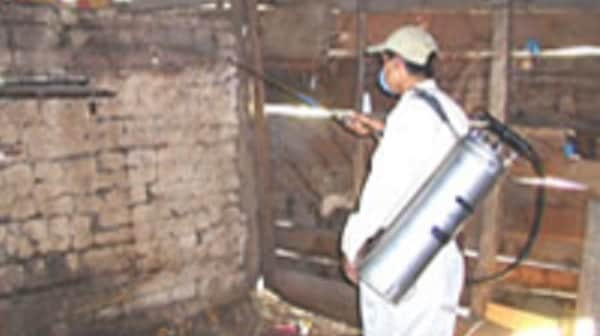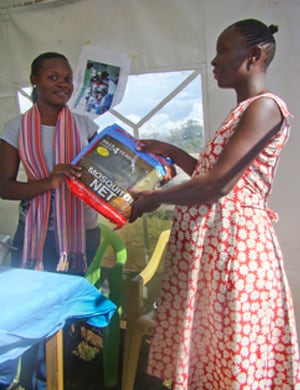Key points
- CDC has worked with the Kenya Medical Research Institute since 1979.
- Over the period, infrastructure and capacity for biomedical research have been established at the KEMRI/CDC Field Station in western Kenya, which has attracted multiple other research partners from the U.S., Europe, and other African countries.
- Today over 300 staff conduct malaria research at the KEMRI/CDC Field Station, designing and evaluating new tools for malaria prevention and control.

Overview
In Kenya, there are an estimated 3.4 million new clinical cases and 11,800 deaths each year, and those living in western Kenya have an especially high risk of malaria. As it does in many countries around the world, CDC has worked closely with the Kenya Ministry of Health to fight malaria. Over four decades ago, CDC established a collaboration with the Kenya Medical Research Institute (KEMRI), which is part of Kenya's Ministry of Health. Led by the Division of Parasitic Diseases and Malaria, CDC's malaria work in Kenya includes
- Capacity strengthening and technical support
- Surveillance, monitoring, and evaluation
- Assessing new tools for vector control, prevention and case management
- Transmission reduction research
- Laboratory strengthening
CDC's efforts in Kenya are also supported by the U.S. President's Malaria Initiative.
Capacity building and technical support
Over the past four decades, CDC has provided onsite technical assistance and funding for malaria research in Kenya as well as technology transfer from CDC to KEMRI, resulting in a well-trained staff of Kenyan scientists, clinicians, laboratory technicians, and field workers. CDC has provided KEMRI with key technological resources that now allow work to be performed locally, which was not possible in the past.
Surveillance, monitoring, and evaluation
CDC and KEMRI work together to conduct health facility surveillance. This surveillance activity involves documenting infections detected at hospital and health center outpatient departments. As many people infected with malaria in western Kenya do not feel ill and therefore do not go to health facilities for malaria treatment, and because malaria transmission fluctuates throughout the year, CDC and KEMRI have developed a novel surveillance platform using pregnant women attending antenatal care as a proxy for community prevalence. Both surveillance activities allow the Kenya Ministry of Health to monitor progress in their implementation of malaria control strategies. Vector and insecticide resistance surveillance is also conducted to better understand how mosquitoes interact with malaria parasites and to measure effectiveness of indoor residual spray and long-lasting insecticide-treated nets. Ongoing monitoring of the number of deaths in facilities and in the community contributes to assessing the impact of malaria intervention scale-up on mortality over time.
Prevention
Vaccines
Vaccines are critical to reducing malaria morbidity and mortality. CDC works closely with KEMRI in both areas. CDC, KEMRI, and other partners conducted a phase III trial on an experimental malaria vaccine (RTS,S/AS01 vaccine candidate). Findings from this study resulted in a positive opinion of the vaccine from the European Medicines Agency (EMA), and a decision from the World Health Organization to sponsor a large scale evaluation of RTS,S's feasibility, impact and safety in children in Ghana, Malawi and Kenya from 2019-2024, which was instrumental in the eventual recommendation for the vaccine in 2021. CDC and KEMRI also collaborated on a phase II study of a fractionated dose of the RTS,S/AS01E vaccine, demonstrating that lower doses of boosters were equally efficacious, and providing evidence that there can be flexibility in the timing of the doses. CDC and KEMRI also led a phase II evaluation of a Plasmodium falciparum Sporozoite Vaccine, the first trial to assess this vaccine in young children.
More Information
Vector control
Vector control is one of the interventions CDC and other global partners use to control malaria. Current activities include:
- Evaluating the durability of different types of long-lasting insecticide-treated nets against malaria vectors (anopheline mosquitoes)
- Evaluating the efficacy of attractive targeted sugar baits (ATSB)
- Evaluating the efficacy of spatial repellents for malaria transmission reduction
Prevention in pregnancy
Collaborating with the Global Malaria in Pregnancy Consortium, CDC works with KEMRI to control malaria by
- Assessment of the effectiveness of sulfadoxine-pyrimethamine for intermittent preventive treatment of malaria in pregnancy
- Evaluation of new drugs and strategies for prevention of malaria in pregnancy, including women who are living with HIV
- Evaluation of health systems and sociocultural obstacles to improve uptake of intermittent preventive treatment of malaria in pregnancy

Case management
Artemisinin combination therapies (ACTs) are the standard treatments for malaria across Africa. It is important to monitor the efficacy of ACTs and to test new therapies. Continued monitoring provides information that can be used to make decisions about changes to national policy if drug resistance develops. CDC, in partnership with KEMRI, has been performing drug efficacy studies for this purpose since 2007.
In 2014, with partners from the Malaria Elimination Consortium of Western Kenya, CDC and KEMRI conducted drug dosing and safety studies for low-dose primaquine and high-dose ivermectin as novel tools for malaria transmission reduction strategies (e.g., mass screen and treat or mass drug administration) when provided in combination with ACTs.
Transmission reduction
CDC is a member of the Global Malaria Transmission Consortium. The Consortium's initial focus was identifying the best way of measuring malaria transmission. This research has included investigating indoor residual spraying and durable wall liners. In 2015, CDC and KEMRI completed a large-scale intermittent mass test and treat (MTaT) study targeting nearly 30,000 people 3 times a year for 2 years; unfortunately, due to the high rates of asymptomatic, submicroscopic parasitemia, this intervention did not have a significant impact on the incidence of clinical malaria or the cumulative incidence of malaria infection and did not reduce malaria parasite prevalence. Additional transmission reduction activities include evaluating ATSBs, spatial repellents, and the use of surveillance platforms to identify transmission foci for targeted interventions.
Laboratory
KEMRI has state-of-the-art malaria laboratories that can support epidemiologic studies and conduct research on
- The immunology of malaria in children and pregnant women
- Parasite resistance to antimalarial drugs
- Host genetic risk factors for severe malaria
KEMRI's and CDC's Atlanta-based laboratory staff collaborate regularly to evaluate substandard antimalarial drug use in the community and conduct pharmacokinetic studies of antimalarials.
